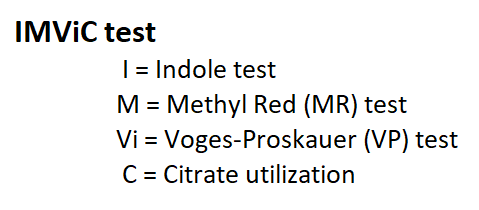Table of Contents
IMViC test
They are some kinds of bacteria which have same size and shape, which we can’t identified through a staining on microscope. So, identification of that type of bacteria are performed by chemically, we performed chemical test for this and one of the chemical examinations of any microscopy bacteria is performed by IMViC test.
This test is performed to determine the presence of Enterobacteria inside the body. This is the biochemical series of test which is performed for differentiate into Enterobacter. It confirms the presence of following bacteria – E-coli, Enterobacter aerogenes and etc.
I = Indole test
M = Methyl Red (MR) test
Vi = Voges-Proskauer (VP) test
C = Citrate utilization
1. Indole production test
Many bacteria series species, with passes enzyme tryptophanase. Tryptophanase degrade amino acid tryptophan to Indole, pyruvate acid and ammonia.
Inoculate the test microorganism into peptone water for check Indole production, incubating at 37°c for 48 to 96 hours (2-4days), then add 0.5 ml of Kovac’s reagent and mix gently.
A red colour layer formed which indicates that positive reaction (production of Indole). E-coli give Indole test positive, so it identified that E-coli present, if bacteria give Indole test.
2. Methyl Red test
This taste is performed to detect the production of acid during the fermentation of glucose. Due to production of acid, pH of the medium falls and it maintained below 4.5
Inoculate the taste microorganism in the glucose phosphate broth, then incubate at 37°C for 2 to 5 days. Then add few drops of 0.04% solution of methyl red, mix well and observe the result in the form of change in colour.
Red colour signifies positive (MR test). Yellow colour signifies negative (MR test). If test is positive then E-coli bacteria. If negative then E-aerogenes. This is the IMViC test.
3. Voges-Proskauer (VP) test
Many bacteria ferment carbohydrates of acetyl methyl carbinol (acetoin). In the presence of alkali and atmospheric oxygen, the small amount of acetyl methyl carbinol present in the medium of oxidised to diacetyl which react the peptone of the broth to give a red colour.
Inoculate test microorganism in glucose phosphate broth, then inoculate at 37°C for 48 hours. Add 1ml potassium hydroxide and 3 ml of 5% solution of α-naphthol in absolute alcohol.
A positive reaction is indicated by the development of pink color in 2-3 minutes. VP test (E-aerogenes give positive) & (E-coli give negative). This is the IMViC test.
4. Citrate utilization
In the test, check the use of citrate as a carbon source for growth. Koser’s citrate as the source of carbon. Ability of microorganisms to use citrate as the carbon source is indicated by the production of turbidity in the medium.
So, finally if organism have ability to use citrate as carbon source, then it gives positive test and if not then negative. Indole, MR, VP and citrate tests are done in routine for the classification of Gram-negative enteric bacteria. This is the IMViC test.


Dear mimprovement.com administrator, Your posts are always a great read.